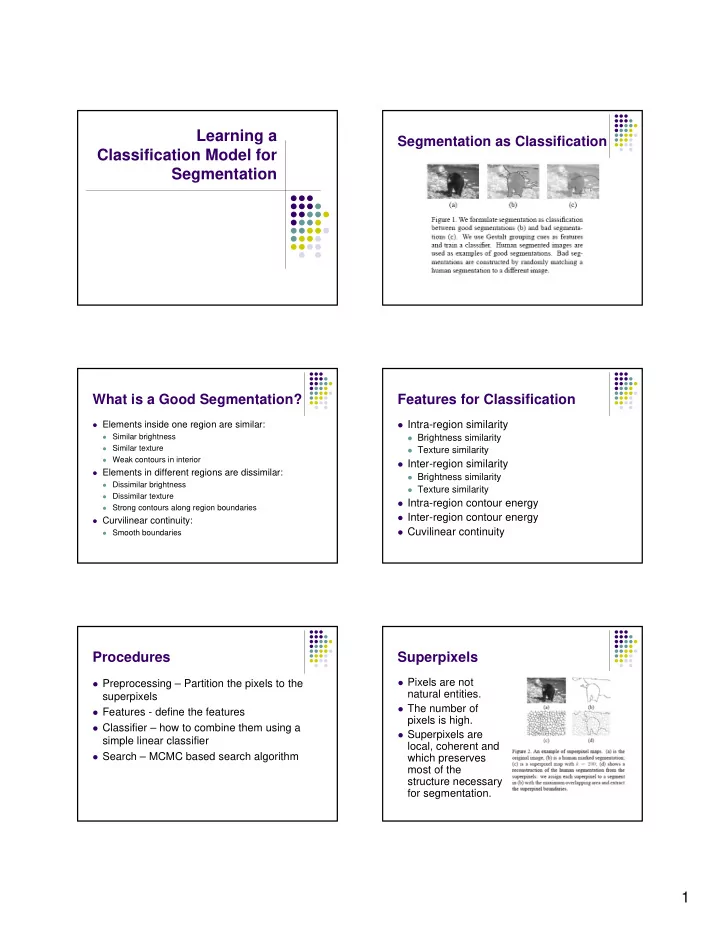

Learning a Segmentation as Classification Classification Model for Segmentation What is a Good Segmentation? Features for Classification � Intra-region similarity � Elements inside one region are similar: � Similar brightness � Brightness similarity � Similar texture � Texture similarity � Weak contours in interior � Inter-region similarity � Elements in different regions are dissimilar: � Brightness similarity � Dissimilar brightness � Texture similarity � Dissimilar texture � Intra-region contour energy � Strong contours along region boundaries � Inter-region contour energy � Curvilinear continuity: � Cuvilinear continuity � Smooth boundaries Procedures Superpixels � Pixels are not � Preprocessing – Partition the pixels to the natural entities. superpixels � The number of � Features - define the features pixels is high. � Classifier – how to combine them using a � Superpixels are simple linear classifier local, coherent and � Search – MCMC based search algorithm which preserves most of the structure necessary for segmentation. 1
Preprocessing: Pixels to Texton Superpixels � The representation of textures using filter responses � Use normalized cut algorithm to make is redundant. superpixels. � Textures with some repeating properties. � The criterion for partitioning the graph � Clustering the filter responses into a small set of � minimize the sum of weights of connections prototype response vectors (textons) is needed. across the groups. � The image is convolved with a bank of filters of multiple orientations. � maximize the sum of weights of connections � Based on the filter output, the pixels are clustered into a within the groups. number of texton channels. � The resulting distribution of textons for each regions makes histograms. Texture Similarity � The texture difference of two regions is measured as the X^2 distance between two histograms. Texture Similarity Contour Energy � The intra-region similarity � The oriented energy at angel 0 is defined as compares the descriptor of a superpixel q to the segment S containing it. � The inter-region similarity compares the descriptor of a superpixel q on the boundary of S’ to the adjacent segment. 2
Contour Energy Good Continuation � Intra-region contour energy is the average � Curvilinear continuity of S is the orientation energy on the superpixel average of tangent changes for boundaries on the interior of S. all pairs of superpixels on the boundary of S. � Inter-region contour energy is the average orientation energy on the boundary of S. Power of the Gestalt Cues Training the classifier Training the classifier Finding good segmentations � Use a simple logistic regression classifier � It becomes the optimization of f in the space of all segmentations. The higher the value of G is, the more likely S is a good segment. � The search space is large, so do the random search. 3
Search for Good Segmentation � Linear objective function � At each step, randomly construct a new segmentation, based on simulated annealing. � Local search dynamics involves three basic moves. � Shift � Merge � Split Conclusion � It treats the segmentation as the classification of good and bad segmentations. � The Gestalt grouping cues are combined in a principled way. � A linear classifier and a simple random search algorithm. � Still difficult optimization problem. 4
Recommend
More recommend